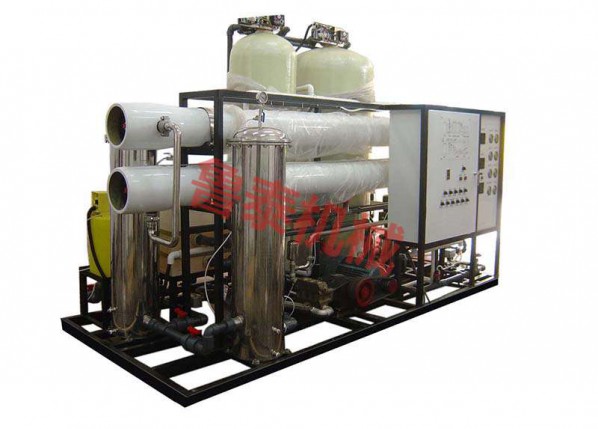Product description
1. Sea water pretreatment
The feedwater pretreatment is the key to guarantee the long-term stable operation of the reverse osmosis system regardless of sea water desalination or brackish water desalination. When making the sea water pretreatment scheme, we shall fully consider that: There are a lot of microorganisms, bacteria and algae in the sea water. The growth of microorganisms, bacteria and algae in the sea water will not only bring many troubles to water intake facilities, but also directly affect the normal work of sea water desalination equipment and process pipe. Due to the periodic rising tide and falling tide, the sea water is mixed up with large quantities of sediment, with large turbidity change, thus easily causing the unstable work of the sea water pretreatment system. The sea water has the strong corrosivity, so the equipment, valve and pipe material used in the system shall be screened and shall have good corrosion resistant performance.
2. Sea water sterilization and algae killing
The foreign sea water desalination engineering almost adds the liquid chlorine, NaClO, CuSO4 and other chemical reagents for sterilization and algae killing. Considering the traffic and other factors, it is a certain difficult to add the chemical reagents for sterilization and algae killing, so the sea water sodium hypochlorite generator is specially used in the engineering equipment research process. A stream of pressurized sea water is separated from the sea water intake pump and enters the sodium hypochlorite generator. It will produce NaClO under the direct current electric field and NaClO is directly poured into the beach sinking well under the potential difference in killing the bacteria, algae, and microorganisms in the sea water.
The generation of NaClO through the direct electrolysis of sea water shall overcome the electrode scaling problem due to the high sea water hardness. It refers to the electrodialysis reversal (EDR) technology in the development process, namely, the electrode polarity will be reversed every 5-10min, thus solving the scaling and precipitation problem of sodium hypochlorite generator effectively.
3. Coagulation and filtration
The coagulation and filtration is to remove the colloid and suspended impurities in the sea water, thus reducing the turbidity. The fouling index (FI) is generally used for metering in the reverse osmosis membrane separation engineering, and the FI value of feed water entering the reverse osmosis equipment shall be <4. Since the sea water specific gravity is larger, the pH value is higher and seasonal change of water temperature is large, the system selects FeCl3 as the coagulant. The coagulant is not affected by the temperature, has big and solid alumen ustum and has fast settling rate.
The engineering project adopts the surface contact coagulation and filtration technology, and it consists of double-layer media filtration and activated carbon filtration. 2 double-layer mechanical filters and 2 activated carbon filters are installed respectively, with the filter diameter of m and filtration rate of 7-8m /s. The filter adopts the steel rubber lining, with the exterior coating of marine paint and interior setting of ABS water distribution by water hat and 316L stainless steel gas exhaust and distribution. To reduce the sea water pretreatment system and transient load and improve the water recovery rate, the reverse osmosis concentrated water system is set as the gas-liquid backwashing system of the filter backwashing water.
3. Reverse osmosis sea water desalination
The sea water has strong corrosion for the equipment due to the high salt content and hardness, and the reverse osmosis sea water desalination system is more complicated than the conventional brackish water desalination system due to the larger seasonal change of water temperature, so the engineering investment and energy consumption are also larger. Therefore, the engineering investment and energy consumption are reduced through the elaborate process design and reasonable equipment configuration, so it is particularly important to reduce the water cost in the unit system and ensure the stable system operation. Marine sea water desalination equipment, large sea water desalination equipment, land sea water desalination equipment
4. Chemical regulation treatment
To prevent the sea water concentration from producing the indissolvable inorganic salt in the sea water desalination process, such as CaCO3 and CaSO4 and from generating the scaling and precipitation on the reverse osmosis membrane surface and system pipe pieces, the scale inhibitor shall be added before the seal water enters the reverse osmosis desalination system.
H2SO4 is added to regulate the sea water pH value for decomposing HCO-3 in the sea water, thus preventing CaCO3 precipitation. It is the most commonly-used and economical method in the sea water desalination. The addition of (NaPO3) 6 (SHMP) is the effective method of preventing CaSO4 precipitation, but (NaPO3) 6 will produce the byproduct phosphate during the scale inhibition, thus helping the growth of microorganisms, bacteria and algae. Its use has some limitations. The special scale inhibitor with high-molecular polymer imported from the western countries is more expensive, which will directly affect the running cost of the sea water desalination engineering. The engineering finally selects H2SO4 as the scale inhibitor, controls the pH value of reverse osmosis system water within 6.8-7.0 and controls the recovery rate of the sea water desalination system, thus preventing the CaSO4 precipitation.
Considering that the reverse osmosis sea water desalination uses the composite membrane element with aromatic polyamide as the membrane material, the residual chlorine content in the feed water shall be below 0.1m g/L due to the poor oxidative resistance, so NaHSO3 shall be added before the sea water enters the membrane system for controlling the oxidation reduction potential (ORP) before the sea water enters the reverse osmosis device and making the sea water ORP before entering the reverse osmosis device reach 280-320mV. The dosing quantity of NaHSO3 is 3 times of the residual chlorine content in the sea water.
5. Chemical regulation treatment
To prevent the sea water concentration from producing the indissolvable inorganic salt in the sea water desalination process, such as CaCO3 and CaSO4 and from generating the scaling and precipitation on the reverse osmosis membrane surface and system pipe pieces, the scale inhibitor shall be added before the seal water enters the reverse osmosis desalination system.
H2SO4 is added to regulate the sea water pH value for decomposing HCO-3 in the sea water, thus preventing CaCO3 precipitation. It is the most commonly-used and economical method in the sea water desalination. The addition of (NaPO3) 6 (SHMP) is the effective method of preventing CaSO4 precipitation, but (NaPO3) 6 will produce the byproduct phosphate during the scale inhibition, thus helping the growth of microorganisms, bacteria and algae. Its use has some limitations. The special scale inhibitor with high-molecular polymer imported from the western countries is more expensive, which will directly affect the running cost of the sea water desalination engineering. The engineering finally selects H2SO4 as the scale inhibitor, controls the pH value of reverse osmosis system water within 6.8-7.0 and controls the recovery rate of the sea water desalination system, thus preventing the CaSO4 precipitation.
Considering that the reverse osmosis sea water desalination uses the composite membrane element with aromatic polyamide as the membrane material, the residual chlorine content in the feed water shall be below 0.1m g/L due to the poor oxidative resistance, so NaHSO3 shall be added before the sea water enters the membrane system for controlling the oxidation reduction potential (ORP) before the sea water enters the reverse osmosis device and making the sea water ORP before entering the reverse osmosis device reach 280-320mV. The dosing quantity of NaHSO3 is 3 times of the residual chlorine content in the sea water.
6. Removal of organic matter and foreign odor and smell in the sea water
The sea water around the island is greatly affected by the surrounding environment, and the chemical oxygen consumption (COD) of the sea water is 1.7-2.5m g/L, so the sea water will have the foreign odor and smell in summer and autumn. Besides the addition of NaClO for oxidation, the activated carbon filter is installed, and the fruit-type granular activated carbon with high mechanical strength is selected for the effective absorption of organic matter and foreign odor and smell, improving the reverse osmosis produced water quality, alleviating the pollution for reverse osmosis membrane surface and extending the membrane service life.
7. System control Marine sea water desalination equipment, large sea water desalination equipment, land sea water desalination equipment
The entire reverse osmosis sea water desalination system design adopts the domestic and foreign advanced computer process control, and the programmable logic controller (PLC) of the industrial personal computer (IPC) operation station constitutes a control system with dispersed sampling control and centralized monitoring and operation. The high and low voltage protection switch is set according to the process parameter. When the conductance, flow and pressure become abnormal, it can realize the automatic switching and automatic interlock alarm and shutdown, thus protecting the high-pressure pump and reverse osmosis membrane element. The startup and shutdown of the high-pressure pump are under the frequency conversion control, and the soft operation of the high-pressure pump is carried out, thus saving energy consumption and preventing the water hammer or back pressure from causing the high-pressure pump and membrane element damage. The programming is made before and after the startup and shutdown of the reverse osmosis device, which can realize the automatic low pressure flushing. Especially during the shutdown, the metastable state of the concentrated sea water will change and the precipitation will appear, thus polluting the membrane surface. The automatic flushing device of low-pressure desalinated water can obtain the concentrated sea water, protect the membrane surface from being polluted and extend the membrane service life. It can realize the display, storage, statistics, and table making and printing of the system temperature, flow, water quality, yield and other related parameters. The dynamic process flow picture in the monitoring operation is clear and intuitive, and the system control simplifies the manual operation, ensuring the automatic, safe and reliable system operation.





